 | | | Switch to: Europe, USA, New Zealand, Antarctica Credit: NOAA/Ovation  Planetary K-index Planetary K-index
Now: Kp= 4.67 unsettled
24-hr max: Kp= 4.67 unsettled
explanation | more data
Interplanetary Mag. Field
Btotal: 15.32 nT
Bz: -0.62 nT south
more data: ACE, DSCOVR
Updated: Today at 1147 UT  Coronal Holes: 09 Feb 25 Coronal Holes: 09 Feb 25 
Solar wind flowing from this coronal hole could reach Earth on Feb. 10-11. Credit: NASA/SDO | more data  Polar Stratospheric Clouds
Colorful Type II polar stratospheric clouds (PSC) form when the temperature in the stratosphere drops to a staggeringly low -85C. NASA's MERRA-2 climate model predicts when the air up there is cold enough: 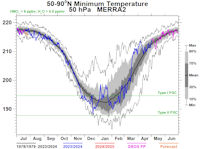
On Feb 09, 2025, the Arctic stratosphere is cold enough for Type II clouds. | more data. Noctilucent Clouds
The southern season for noctilucent clouds (NLCs) is underway!. The first clouds were detected over Antarctica on Nov. 19, 2024. Here is the current NLC map from the NOAA 21 satellite.
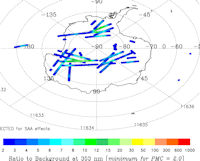
Updated: Feb. 7, 2025
An instrument onboard NOAA 21 (OMPS LP) is able to detect NLCs (also known as "polar mesospheric clouds" or PMCs). In the daily map, above, each dot is a detected cloud. As the season progresses, these dots will multiply in number and shift in hue from blue to red as the brightness of the clouds intensifies.
 SPACE WEATHER
NOAA Forecasts | | Updated at: 2025 Feb 09 2200 UTC FLARE | 0-24 hr | 24-48 hr | CLASS M | 55 % | 55 % | CLASS X | 10 % | 10 % |  Geomagnetic Storms: Geomagnetic Storms:
Probabilities for significant disturbances in Earth's magnetic field are given for three activity levels: active, minor storm, severe storm Updated at: 2025 Feb 09 2200 UTC Mid-latitudes | 0-24 hr | 24-48 hr | ACTIVE | 40 % | 40 % | MINOR | 25 % | 20 % | SEVERE | 05 % | 05 % | High latitudes | 0-24 hr | 24-48 hr | ACTIVE | 10 % | 10 % | MINOR | 25 % | 25 % | SEVERE | 60 % | 60 % | | | |  | | | | | | | | | | | This is an AI Free Zone! Text created by Large Language Models is spreading rapidly across the Internet. It's well-written, but frequently inaccurate. If you find a mistake on Spaceweather.com, rest assured it was made by a real human being. | | | GEOMAGNETIC STORM WATCH (G1): NOAA forecasters say there is a chance of G1-class geomagnetic storms on Feb. 10-11 when a stream of solar wind is expecte to hit Earth's magnetic field. The gaseous material is flowing from a crescent-shaped hole in the sun's atmosphere. Aurora alerts: SMS Text. ASTEROID 2024 YR4 UPDATE: It's not scary yet, but it's heading in that direction. Asteroid 2024 YR4 now has a 2.2% chance of hitting Earth on Dec. 22, 2032, almost double the odds from a month and a half ago when it was first discovered. Current probabilities are based on 343 observations spanning 45 days, a growing number which is improving our knowledge of the asteroid's orbit. 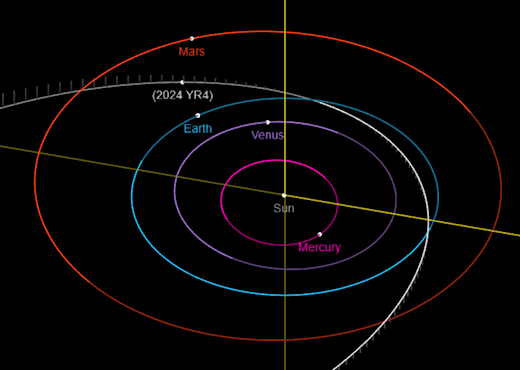
Click to view and play with an interactive orbit of asteroid 2024 YR4
Even if the odds eventually grow to 100%, 2024 YR4 won't wipe us out. This asteroid is no dino-killer. With an estimated diameter of 40 to 70 meters, it is only a few times larger than the Chelyabinsk meteor that hit Russia in 2013. That space rock exploded in the atmosphere, creating shock waves that shattered glass windows and injured hundreds of people (mainly from broken glass). An impact from 2024 YR4 might be more like the Tunguska event, which leveled a forest in Russia in 1908. You wouldn't want to be at ground zero, but Earth will survive. The recent uptick in impact probability could be temporary. Astronomers are carefully tracking 2024 YR4 with multiple observations every night. More data will tighten the error bars and alter the odds. Up or down? Stay tuned for updates. Realtime Space Weather Photo Gallery
Free: Spaceweather.com Newsletter VALENTINE'S GIFTS FROM THE EDGE OF SPACE: Does your sweetheart love space? Shop the Earth to Sky Store for their perfect Valentine's gift. All items have flown to the stratosphere on board cosmic ray research balloons--and from now until Feb. 14th, everything is 10% off:

Each purchase comes with a greeting card showing the item in flight and telling the story of its journey to the stratosphere and back again. Don't forget to enter the coupon code "FAROUT" for your Valentine's discount! Far Out Gifts: Earth to Sky Store
All sales support hands-on STEM education
Realtime Aurora Photo Gallery
Free: Spaceweather.com Newsletter
Realtime Comet ATLAS Photo Gallery
Free: Spaceweather.com Newsletter Every night, a network of NASA all-sky cameras scans the skies above the United States for meteoritic fireballs. Automated software maintained by NASA's Meteoroid Environment Office calculates their orbits, velocity, penetration depth in Earth's atmosphere and many other characteristics. Daily results are presented here on Spaceweather.com. On Feb 08, 2025, the network reported 2 fireballs.
(2 sporadics) 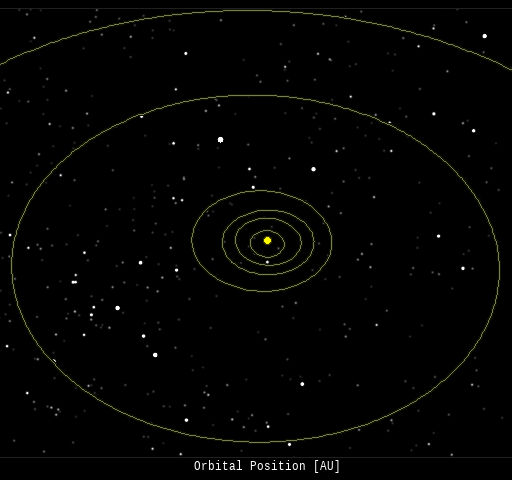 In this diagram of the inner solar system, all of the fireball orbits intersect at a single point--Earth. The orbits are color-coded by velocity, from slow (red) to fast (blue). [Larger image] [movies] Potentially Hazardous Asteroids ( PHAs) are space rocks larger than approximately 100m that can come closer to Earth than 0.05 AU. None of the known PHAs is on a collision course with our planet, although astronomers are finding new ones all the time. On February 9, 2025 there were 2349 potentially hazardous asteroids.
 | Recent & Upcoming Earth-asteroid encounters: | Asteroid | Date(UT) | Miss Distance | Velocity (km/s) | Diameter (m) | | 2002 CC14 | 2025-Feb-04 | 8.4 LD | 12.7 | 39 | | 2025 BB2 | 2025-Feb-04 | 0.8 LD | 6.5 | 26 | | 2025 CC2 | 2025-Feb-04 | 16.4 LD | 14.9 | 30 | | 2025 BR | 2025-Feb-04 | 12.3 LD | 6 | 18 | | 2025 CN1 | 2025-Feb-04 | 11.9 LD | 9.9 | 20 | | 2025 CQ3 | 2025-Feb-05 | 10.3 LD | 15.5 | 29 | | 2025 CC | 2025-Feb-05 | 16.7 LD | 4.8 | 11 | | 2025 CQ | 2025-Feb-05 | 5.9 LD | 16.9 | 47 | | 2025 CQ1 | 2025-Feb-05 | 2.3 LD | 18.1 | 20 | | 2025 CM | 2025-Feb-05 | 0.8 LD | 6.6 | 14 | | 2025 CA1 | 2025-Feb-05 | 2.9 LD | 9.7 | 10 | | 2025 CK1 | 2025-Feb-06 | 4.1 LD | 10.1 | 9 | | 2025 CR1 | 2025-Feb-06 | 1.3 LD | 6 | 3 | | 2025 CP1 | 2025-Feb-06 | 1.5 LD | 11.1 | 7 | | 2025 CJ | 2025-Feb-06 | 1.6 LD | 4.9 | 8 | | 2025 CZ1 | 2025-Feb-07 | 0.8 LD | 12.8 | 5 | | 2016 CO248 | 2025-Feb-07 | 13.5 LD | 5.9 | 11 | | 2020 GZ2 | 2025-Feb-07 | 17.7 LD | 8.9 | 9 | | 2022 PK1 | 2025-Feb-07 | 15 LD | 11 | 33 | | 2025 CG | 2025-Feb-08 | 5.5 LD | 9 | 18 | | 2025 CK | 2025-Feb-08 | 5.4 LD | 5.1 | 8 | | 2025 CT3 | 2025-Feb-09 | 19.7 LD | 16.9 | 57 | | 2012 PB20 | 2025-Feb-09 | 3.5 LD | 4.3 | 37 | | 2025 CJ3 | 2025-Feb-10 | 6.1 LD | 8.7 | 22 | | 2025 CF1 | 2025-Feb-10 | 11.3 LD | 12.6 | 26 | | 2025 CO | 2025-Feb-10 | 14.4 LD | 10.1 | 19 | | 2025 CV | 2025-Feb-12 | 12.4 LD | 9.4 | 15 | | 2025 CL3 | 2025-Feb-13 | 9.3 LD | 12.5 | 31 | | 2025 CN2 | 2025-Feb-13 | 3.9 LD | 8.4 | 9 | | 2025 CR | 2025-Feb-15 | 13 LD | 10.1 | 31 | | 2004 XG | 2025-Feb-16 | 15.6 LD | 9.1 | 54 | | 2025 CO1 | 2025-Feb-16 | 18.1 LD | 7.4 | 26 | | 2025 BX1 | 2025-Feb-16 | 7.2 LD | 10.3 | 48 | | 2024 UD26 | 2025-Feb-16 | 16.8 LD | 9.3 | 250 | | 2025 CA2 | 2025-Feb-18 | 13.3 LD | 7.4 | 22 | | 2014 CE13 | 2025-Feb-19 | 9 LD | 16.8 | 55 | | 2022 DG2 | 2025-Feb-19 | 11.5 LD | 10.4 | 7 | | 2016 AX165 | 2025-Feb-20 | 14.9 LD | 9.2 | 89 | | 2015 BK509 | 2025-Feb-25 | 9.4 LD | 14.6 | 119 | | 2023 RW3 | 2025-Feb-25 | 7.4 LD | 5.1 | 18 | | 2025 CV1 | 2025-Mar-02 | 16.5 LD | 10.4 | 49 | | 535844 | 2025-Mar-05 | 9.6 LD | 7.9 | 149 | | 2021 EU3 | 2025-Mar-10 | 10.7 LD | 4.4 | 13 | | 2025 CT1 | 2025-Mar-13 | 19.4 LD | 2.9 | 29 | | 2020 FO | 2025-Mar-15 | 13.4 LD | 20.6 | 23 | | 2025 CX1 | 2025-Mar-15 | 19.9 LD | 8.4 | 43 | | 2021 FH1 | 2025-Mar-21 | 3.9 LD | 13.8 | 31 | | 2014 TN17 | 2025-Mar-26 | 13.3 LD | 21.5 | 174 | | 2020 VA4 | 2025-Mar-30 | 11.6 LD | 5.6 | 12 | | 2022 FR3 | 2025-Apr-01 | 6.6 LD | 7.4 | 102 | | 2020 XT2 | 2025-Apr-04 | 13.6 LD | 6.2 | 41 | | 2023 GC2 | 2025-Apr-04 | 17.3 LD | 6.3 | 12 | | 2020 FH4 | 2025-Apr-04 | 12.8 LD | 3 | 7 | | 2025 BC10 | 2025-Apr-05 | 9.7 LD | 22.9 | 473 | | 2007 SQ6 | 2025-Apr-05 | 10.9 LD | 6.6 | 129 | | 2003 GQ22 | 2025-Apr-07 | 19.6 LD | 8.9 | 180 | Notes: LD means "Lunar Distance." 1 LD = 384,401 km, the distance between Earth and the Moon. 1 LD also equals 0.00256 AU. | | Cosmic Rays in the Atmosphere | SPACE WEATHER BALLOON DATA: Almost once a week, Spaceweather.com and the students of Earth to Sky Calculus fly space weather balloons to the stratosphere over California. These balloons are equipped with sensors that detect secondary cosmic rays, a form of radiation from space that can penetrate all the way down to Earth's surface. Our monitoring program has been underway without interruption for 10 years, resulting in a unique dataset of in situ atmospheric measurements. Latest results (Nov. 2024): Atmospheric radiation is decreasing in 2024. Our latest measurements in November registered a 10-year low: 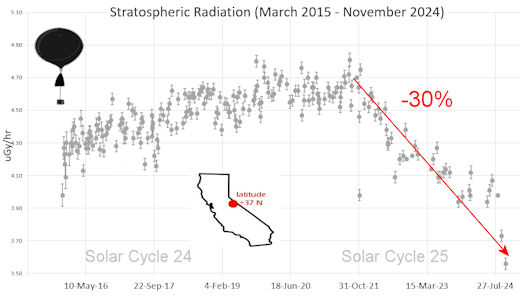
What's going on? Ironically, the radiation drop is caused by increasing solar activity. Solar Cycle 25 has roared to life faster than forecasters expected. The sun's strengthening and increasingly tangled magnetic field repels cosmic rays from deep space. In addition, solar coronal mass ejections (CMEs) sweep aside cosmic rays, causing sharp reductions called "Forbush Decreases." The two effects blend together to bring daily radiation levels down. .Who cares? Cosmic rays are a surprisingly "down to Earth" form of space weather. They can alter the chemistry of the atmosphere, trigger lightning, and penetrate commercial airplanes. According to a study from the Harvard T.H. Chan school of public health, crews of aircraft have higher rates of cancer than the general population. The researchers listed cosmic rays, irregular sleep habits, and chemical contaminants as leading risk factors. A number of controversial studies (#1, #2, #3, #4) go even further, linking cosmic rays with cardiac arrhythmias and sudden cardiac death. Technical notes: The radiation sensors onboard our helium balloons detect X-rays and gamma-rays in the energy range 10 keV to 20 MeV. These energies span the range of medical X-ray machines and airport security scanners. Data points in the graph labeled "Stratospheric Radiation" correspond to the peak of the Regener-Pfotzer maximum, which lies about 67,000 feet above central California. When cosmic rays crash into Earth's atmosphere, they produce a spray of secondary particles that is most intense at the entrance to the stratosphere. Physicists Eric Regener and Georg Pfotzer discovered the maximum using balloons in the 1930s and it is what we are measuring today. | | The official U.S. government space weather bureau | | | The first place to look for information about sundogs, pillars, rainbows and related phenomena. | | | Researchers call it a "Hubble for the sun." SDO is the most advanced solar observatory ever. | | | 3D views of the sun from NASA's Solar and Terrestrial Relations Observatory | | | Realtime and archival images of the Sun from SOHO. | | | information about sunspots based on the latest NOAA/USAF Active Region Summary | | | current counts of failed and deployed Starlink satellites from Jonathan's Space Page. See also, all satellite statistics. | | | Authoritative predictions of space junk and satellite re-entries | | | from the NOAA Space Environment Center | | | fun to read, but should be taken with a grain of salt! Forecasts looking ahead more than a few days are often wrong. | | | from the NOAA Space Environment Center | | | the underlying science of space weather |  | Got a chipped or cracked windshield that prevents you from seeing space weather events while driving? Get windshield replacement from SR Windows & Glass with free mobile auto glass service anywhere in the Phoenix area. |  | BestCSGOGambling is the best site for everything related to CSGO gambling on the web | | | These links help Spaceweather.com stay online. Thank you to our supporters! | | | | | | | | |  | |  |   | ©2021 Spaceweather.com. All rights reserved. This site is penned daily by Dr. Tony Phillips. | |

